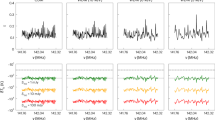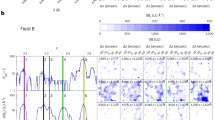Abstract
Dark matter is the dominant form of matter in the Universe, but its nature is unknown. It is plausibly an elementary particle, perhaps the lightest supersymmetric partner of known particle species1. In this case, annihilation of dark matter in the halo of the Milky Way should produce γ-rays at a level that may soon be observable2,3. Previous work has argued that the annihilation signal will be dominated by emission from very small clumps4,5 (perhaps smaller even than the Earth), which would be most easily detected where they cluster together in the dark matter haloes of dwarf satellite galaxies6. Here we report that such small-scale structure will, in fact, have a negligible impact on dark matter detectability. Rather, the dominant and probably most easily detectable signal will be produced by diffuse dark matter in the main halo of the Milky Way7,8. If the main halo is strongly detected, then small dark matter clumps should also be visible, but may well contain no stars, thereby confirming a key prediction of the cold dark matter model.
This is a preview of subscription content, access via your institution
Access options
Subscribe to this journal
Receive 51 print issues and online access
$199.00 per year
only $3.90 per issue
Buy this article
- Purchase on Springer Link
- Instant access to full article PDF
Prices may be subject to local taxes which are calculated during checkout




Similar content being viewed by others
References
Bertone, G., Hooper, D. & Silk, J. Particle dark matter: Evidence, candidates and constraints. Phys. Rep. 405, 279–390 (2005)
Gehrels, N. & Michelson, P. GLAST: The next-generation high energy gamma-ray astronomy mission. Astropart. Phys. 11, 277–282 (1999)
Baltz, E. A. et al. Pre-launch estimates for GLAST sensitivity to dark matter annihilation signals. J. Cosmol. Astropart. Phys. 7 013 doi: 10.1088/1475-7516/2008/07/013 (2008)
Calcáneo-Roldán, C. & Moore, B. Surface brightness of dark matter: Unique signatures of neutralino annihilation in the galactic halo. Phys. Rev. D 62, 123005 (2000)
Berezinsky, V., Dokuchaev, V. & Eroshenko, Y. Small-scale clumps in the galactic halo and dark matter annihilation. Phys. Rev. D 68, 103003 (2003)
Strigari, L. E., Koushiappas, S. M., Bullock, J. S. & Kaplinghat, M. Precise constraints on the dark matter content of Milky Way dwarf galaxies for gamma-ray experiments. Phys. Rev. D 75, 083526 (2007)
Berezinsky, V., Bottino, A. & Mignola, G. High energy gamma-radiation from the Galactic center due to neutralino annihilation. Phys. Lett. B 325, 136–142 (1994)
Bergström, L., Ullio, P. & Buckley, J. H. Observability of gamma rays from dark matter neutralino annihilations in the Milky Way halo. Astropart. Phys. 9, 137–162 (1998)
Navarro, J. F., Frenk, C. S. & White, S. D. M. A universal density profile from hierarchical clustering. Astrophys. J. 490, 493–508 (1997)
Strigari, L. E. et al. Redefining the missing satellites problem. Astrophys. J. 669, 676–683 (2007)
Peñarrubia, J., McConnachie, A. W. & Navarro, J. F. The cold dark matter halos of local group dwarf spheroidals. Astrophys. J. 672, 904–913 (2008)
Springel, V. et al. in High Performance Computing in Science and Engineering, Munich 2007 (eds Wagner, S., Steinmetz, M., Bode, A. & Brehm, M.) 93–108 (Springer, 2008)
Diemand, J. et al. Clumps and streams in the local dark matter distribution. Nature 754, 735–738 (2008)
Prada, F., Klypin, A., Flix, J., Martínez, M. & Simonneau, E. Dark matter annihilation in the Milky Way galaxy: Effects of baryonic compression. Phys. Rev. Lett. 93, 241301 (2004)
Mohayaee, R., Shandarin, S. & Silk, J. Dark matter caustics and the enhancement of self-annihilation flux. J. Cosmol. Astropart. Phys. 5 015 doi: 10.1088/1475-7516/2007/05/015 (2007)
Hofmann, S., Schwarz, D. J. & Stöcker, H. Damping scales of neutralino cold dark matter. Phys. Rev. D 64, 083507 (2001)
De Lucia, G. et al. Substructures in cold dark matter haloes. Mon. Not. R. Astron. Soc. 348, 333–344 (2004)
Gao, L., White, S. D. M., Jenkins, A., Stoehr, F. & Springel, V. The subhalo populations of ΛCDM dark haloes. Mon. Not. R. Astron. Soc. 355, 819–834 (2004)
Michelson, P. F. in The First GLAST Symposium (eds Ritz, S., Michelson, P. & Meegan, C. A.) 8–12 (AIP Conference Series, Vol. 921, American Institute of Physics, 2007)
Hunter, S. D. et al. EGRET observations of the diffuse gamma-ray emission from the galactic plane. Astrophys. J. 481, 205–240 (1997)
Strong, A. W., Moskalenko, I. V. & Reimer, O. Diffuse galactic continuum gamma rays: A model compatible with EGRET data and cosmic-ray measurements. Astrophys. J. 613, 962–976 (2004)
Aloisio, R., Blasi, P. & Olinto, A. V. Gamma-ray constraints on neutralino dark matter clumps in the galactic halo. Astrophys. J. 601, 47–53 (2004)
Kuhlen, M., Diemand, J. & Madau, P. The dark matter annihilation signal from galactic substructure: Predictions for GLAST. Astrophys. J. (in the press); preprint at 〈http://arxiv.org/abs/0805.4416〉.
Strigari, L. E. et al. The most dark-matter-dominated galaxies: Predicted gamma-ray signals from the faintest Milky Way dwarfs. Astrophys. J. 678, 614–620 (2008)
Evans, N. W., Ferrer, F. & Sarkar, S. A travel guide to the dark matter annihilation signal. Phys. Rev. D 69, 123501 (2004)
Koushiappas, S. M., Zentner, A. R. & Walker, T. P. Observability of gamma rays from neutralino annihilations in the Milky Way substructure. Phys. Rev. D 69, 043501 (2004)
Stoehr, F., White, S. D. M., Springel, V., Tormen, G. & Yoshida, N. Dark matter annihilation in the halo of the Milky Way. Mon. Not. R. Astron. Soc. 345, 1313–1322 (2003)
Peirani, S., Mohayaee, R. & de Freitas Pacheco, J. A. Indirect search for dark matter: Prospects for GLAST. Phys. Rev. D 70, 043503 (2004)
Pieri, L., Branchini, E. & Hofmann, S. Difficulty of detecting minihalos via γ rays from dark matter annihilation. Phys. Rev. Lett. 95, 211301 (2005)
Springel, V., White, S. D. M., Tormen, G. & Kauffmann, G. Populating a cluster of galaxies — I. Results at z = 0. Mon. Not. R. Astron. Soc. 328, 726–750 (2001)
Acknowledgements
We thank the Leibniz Supercomputing Centre of the Bavarian Academy of Sciences and Humanities, and the Computing Centre of the Max-Planck Society in Garching, where the simulations were carried out. C.S.F. acknowledges a Royal Society-Wolfson Research Merit award. This work was supported in part by an STFC Rolling Grant to the ICC.
Author information
Authors and Affiliations
Corresponding author
Supplementary information
Supplementary Information
This file contains Supplementary Notes, Supplementary Figures 5-8 and Supplementary References. The signal-to-noise calculation and the treatment of the background are described in detail and all-sky maps of the different emission components are shown. (PDF 453 kb)
Rights and permissions
About this article
Cite this article
Springel, V., White, S., Frenk, C. et al. Prospects for detecting supersymmetric dark matter in the Galactic halo. Nature 456, 73–76 (2008). https://doi.org/10.1038/nature07411
Received:
Accepted:
Issue Date:
DOI: https://doi.org/10.1038/nature07411
This article is cited by
-
Large-scale dark matter simulations
Living Reviews in Computational Astrophysics (2022)
-
Cosmological simulations of galaxy formation
Nature Reviews Physics (2020)
-
Universal structure of dark matter haloes over a mass range of 20 orders of magnitude
Nature (2020)
-
Status of dark matter detection
Frontiers of Physics (2013)
-
Cosmic ray anomalies from the MSSM?
Journal of High Energy Physics (2011)
Comments
By submitting a comment you agree to abide by our Terms and Community Guidelines. If you find something abusive or that does not comply with our terms or guidelines please flag it as inappropriate.



